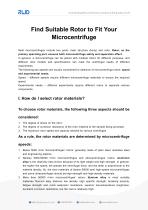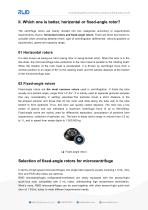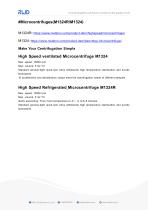 Website:
RWD Life Science
Website:
RWD Life Science
Catalog excerpts

Find Suitable Rotor to Fit Your Microcentrifuge Most microcentrifuges include two parts: main structure (body) and rotor. Rotor, as the primary operating part, ensures both microcentrifuge safety and separation effect. In general, a microcentrifuge can be paired with multiple rotors for different purposes, and different rotor models and specifications can meet the centrifugal needs of different experiments. The following two aspects are usually considered for selection of microcentrifuge rotors: speed and experimental needs. Speed – different speeds require different microcentrifuge materials to ensure the required speed. Experimental needs – different experiments require different rotors to separate various components. I. How do I select rotor materials? To choose rotor materials, the following three aspects should be considered: 1. The degree of stress on the rotor; 2. The degree of corrosion resistance of the rotor material to the sample being processe. 3. The maximum rotor speed and capacity allowed by various centrifuges. As a rule, the rotor materials are determined by microcentrifuge speeds: 1. Below 5000 r/min microcentrifuges’ rotors: generally made of plain steel, stainless steel and engineering plastics. 2. Namely 5000-50000 r/min microcentrifuges and ultracentriufuges’ rotors: aluminum alloy is the relatively best choice because of its light weight and high strength. In general, the higher the speed, the greater the centrifugal force, and the latter is proportional to the material density. So, the rotor materials of (below 50000 rpm) high-speed microcentrifuges and some ultracentrifuges should be high-strength and high-density materials. 3. More than 50000 r/min microcentrifuges’ rotors: titanium alloy is most suitable materials.Titanium alloy features low density, high specific strength, breaking tenacity, fatigue strength and crack extension resistance, superior low-temperature toughness, excellent corrosion resistance, but the cost is relatively hig
Open the catalog to page 1
II. Which one is better, horizontal or fixed-angle rotor? The centrifuge rotors are mainly divided into two categories according to experimental requirements, that is, horizontal rotors and fixed-angle rotors. There are three key factors to consider when choosing between them: type of centrifugation (differential, velocity gradient or equidensity), speed and capacity range. 01 Horizontal rotors It is also known as swing-out rotor (swing rotor or swing-bucket rotor). When the rotor is in the idle state, the microcentrifuge tube centerline in the rotor head is parallel to the rotating shaft....
Open the catalog to page 2
#Microcentrifuges(M1324R/M1324) M1324R: https://www.rwdstco.com/product-item/highspeedmicrocentrifuge/ M1324: https://www.rwdstco.com/product-item/benchtop-microcentrifuge/ Make Your Centrifugation Simple High Speed ventilated Microcentrifuge M1324 Max. speed: 15800 rpm Max. volume: 5 mL*10 Standard aerosol-tight quick-lock rotos withstands high temperature sterilization and avoids biohazards 10 acceleration and deceleration ramps meet the centrifugation needs of different samples High Speed Refrigerated Microcentrifuge M1324R Max. speed: 15800 rpm Max. volume: 5 mL*10 Quick precooling....
Open the catalog to page 3All RWD Life Science catalogs and technical brochures
-
RWD Gradient Thermal Cycler
2 Pages
-
Rotary Microtomes S710
2 Pages
-
RWD Osmotic infusion Pump
2 Pages
-
RWD Syringe Pump R462
1 Pages
-
RWD Rotating impactor 68099Ⅱ
2 Pages
-
RWD Microcentrifuge M1324R
2 Pages
-
RWD Infusion imager RFLSI Ⅲ
2 Pages
-
RWD Surgical Instruments
18 Pages
-
RWD Veterinary medical equipment
32 Pages
-
RWD R415 Animal Ventilatorr
1 Pages
-
PRODUCT CATALOGUE 2017
51 Pages
-
2015 Product Catalogue
44 Pages
















































































